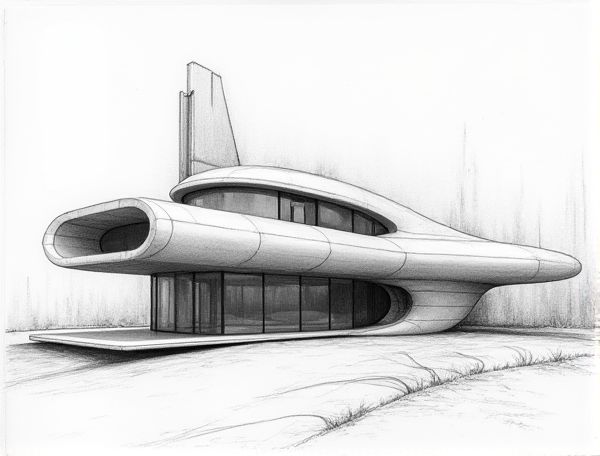
Photo illustration: Neo-futurist home design with kinetic façade elements
Neo-futurist home design integrates kinetic facade elements that dynamically adapt to environmental conditions, enhancing energy efficiency and aesthetic appeal. Discover how your living space can transform with innovative technologies by reading more in the article.
Introduction to Neo-Futurist Home Design
Neo-futurist home design embraces innovative architecture characterized by sleek lines, advanced materials, and sustainable technologies that redefine modern living spaces. This design philosophy prioritizes functionality and environmental harmony, integrating smart home systems and energy-efficient solutions for optimal comfort. Your home becomes a dynamic fusion of form and function, reflecting cutting-edge aesthetics while promoting eco-conscious lifestyles.
Defining Kinetic Façade Elements
Kinetic facade elements incorporate dynamic components such as operable louvers, sliding panels, and adjustable shading devices that respond to environmental changes like sunlight, wind, and temperature. These adaptable features improve energy efficiency by optimizing natural light and ventilation while enhancing the building's aesthetic appeal through movement and transformation. Integration of smart sensors and automated control systems enables precise adjustments, creating a responsive and sustainable architectural envelope.
Historical Influences on Neo-Futurism in Architecture
Neo-futurism in architecture draws heavily from early 20th-century modernist movements like Futurism and Constructivism, which emphasized dynamic forms and technological optimism. Key historical influences include the works of visionary architects such as Buckminster Fuller and Eero Saarinen, who integrated innovative materials and structural engineering into their designs. The movement continues to evolve by blending cutting-edge technology with organic shapes, reflecting a futuristic vision rooted in past avant-garde principles.
Key Features of Neo-Futurist Residential Spaces
Neo-futurist residential spaces emphasize organic shapes, sustainable materials, and advanced smart home technology to create harmonious and energy-efficient living environments. These homes often integrate dynamic lighting systems, adaptive spatial configurations, and eco-friendly innovations that respond to occupants' needs, enhancing comfort and functionality.
Innovations in Kinetic Façade Technology
Kinetic facade technology revolutionizes home designing by integrating dynamic elements that respond to environmental changes, optimizing natural light and energy efficiency. Your home benefits from adaptive shading systems and movable panels that enhance aesthetic appeal while reducing energy costs.
Sustainability Benefits of Dynamic Façades
Dynamic facades enhance energy efficiency by optimizing natural light and reducing heat gain, significantly lowering HVAC energy consumption. These adaptive systems contribute to sustainable building certifications such as LEED and BREEAM by minimizing carbon footprints. Incorporating dynamic facades supports eco-friendly construction with smart materials that respond to environmental changes, promoting long-term sustainability.
Integration of Smart Home Systems
Integration of smart home systems enhances energy efficiency by connecting lighting, heating, and security through centralized control. Voice-activated assistants and automated sensors optimize convenience and real-time monitoring, boosting safety and comfort. Seamless connectivity between devices ensures personalized settings and efficient management of household functions.
Iconic Examples of Neo-Futurist Homes
Neo-futurist homes showcase innovative architectural designs that emphasize fluid shapes, sustainable materials, and cutting-edge technology. Iconic examples include Zaha Hadid's Heydar Aliyev Center, featuring sweeping curves and dynamic forms that blend art with function, and the Morpheus Hotel in Macau, which incorporates irregular geometry and open spaces creating an immersive experiential environment. These designs elevate home aesthetics through structural experimentation and eco-conscious solutions, setting new standards in modern residential architecture.
Challenges in Implementing Kinetic Facades
Implementing kinetic facades in home design presents challenges such as high installation costs, complex engineering requirements, and maintenance difficulties due to moving parts exposed to weather elements. Designers must also address energy consumption concerns and integration with building automation systems to ensure functionality and sustainability.
Future Trends in Adaptive Home Design
Emerging technologies like smart materials and AI-driven home automation are revolutionizing future trends in adaptive home design, enabling customizable living spaces that respond dynamically to your needs and environmental changes. Emphasizing sustainability, these innovations incorporate energy-efficient systems, modular components, and flexible layouts to create resilient homes that evolve with your lifestyle.
 homedesy.com
homedesy.com